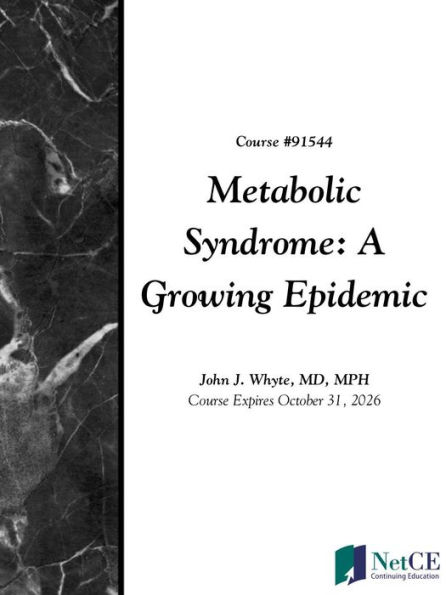Metabolic Syndrome: A Growing Epidemic
As metabolic syndrome continues to become a more prevalent problem in the United States, healthcare professionals will encounter patients with this constellation of symptoms on a more frequent basis. The purpose of this course is to educate healthcare professionals about the epidemiology and treatment of metabolic syndrome so they may better care for their patients. In addition, members of the public may use this course to enhance their personal knowledge of the subject matter presented.
Upon completion of this course, you should be able to:
1. Define metabolic syndrome.
2. Discuss the epidemiology of metabolic syndrome in the United States, based on age, sex, race, and other factors.
3. Evaluate risk factors of metabolic syndrome.
4. Utilize screening tools to diagnose metabolic syndrome.
5. Offer current dietary recommendations.
6. Identify the current physical activity recommendations.
7. Consider pharmaceutical interventions currently available for obesity.
8. Recognize circumstances when surgery should be considered as a treatment option for obesity.
9. Define dyslipidemia and its treatment recommendations.
10. Evaluate hypertension and its treatment modalities.
This 5-hour continuing education course is available for download for professional development; if continuing education credit is desired, please see instructions included in eBook.
"1144341513"
Upon completion of this course, you should be able to:
1. Define metabolic syndrome.
2. Discuss the epidemiology of metabolic syndrome in the United States, based on age, sex, race, and other factors.
3. Evaluate risk factors of metabolic syndrome.
4. Utilize screening tools to diagnose metabolic syndrome.
5. Offer current dietary recommendations.
6. Identify the current physical activity recommendations.
7. Consider pharmaceutical interventions currently available for obesity.
8. Recognize circumstances when surgery should be considered as a treatment option for obesity.
9. Define dyslipidemia and its treatment recommendations.
10. Evaluate hypertension and its treatment modalities.
This 5-hour continuing education course is available for download for professional development; if continuing education credit is desired, please see instructions included in eBook.
Metabolic Syndrome: A Growing Epidemic
As metabolic syndrome continues to become a more prevalent problem in the United States, healthcare professionals will encounter patients with this constellation of symptoms on a more frequent basis. The purpose of this course is to educate healthcare professionals about the epidemiology and treatment of metabolic syndrome so they may better care for their patients. In addition, members of the public may use this course to enhance their personal knowledge of the subject matter presented.
Upon completion of this course, you should be able to:
1. Define metabolic syndrome.
2. Discuss the epidemiology of metabolic syndrome in the United States, based on age, sex, race, and other factors.
3. Evaluate risk factors of metabolic syndrome.
4. Utilize screening tools to diagnose metabolic syndrome.
5. Offer current dietary recommendations.
6. Identify the current physical activity recommendations.
7. Consider pharmaceutical interventions currently available for obesity.
8. Recognize circumstances when surgery should be considered as a treatment option for obesity.
9. Define dyslipidemia and its treatment recommendations.
10. Evaluate hypertension and its treatment modalities.
This 5-hour continuing education course is available for download for professional development; if continuing education credit is desired, please see instructions included in eBook.
Upon completion of this course, you should be able to:
1. Define metabolic syndrome.
2. Discuss the epidemiology of metabolic syndrome in the United States, based on age, sex, race, and other factors.
3. Evaluate risk factors of metabolic syndrome.
4. Utilize screening tools to diagnose metabolic syndrome.
5. Offer current dietary recommendations.
6. Identify the current physical activity recommendations.
7. Consider pharmaceutical interventions currently available for obesity.
8. Recognize circumstances when surgery should be considered as a treatment option for obesity.
9. Define dyslipidemia and its treatment recommendations.
10. Evaluate hypertension and its treatment modalities.
This 5-hour continuing education course is available for download for professional development; if continuing education credit is desired, please see instructions included in eBook.
0.0
In Stock
5
1

Metabolic Syndrome: A Growing Epidemic

Metabolic Syndrome: A Growing Epidemic
eBook
FREE
Related collections and offers
0.0
In Stock

Product Details
| BN ID: | 2940185961520 |
|---|---|
| Publisher: | NetCE |
| Publication date: | 11/01/2023 |
| Sold by: | Barnes & Noble |
| Format: | eBook |
| Sales rank: | 204,909 |
| File size: | 272 KB |
From the B&N Reads Blog
